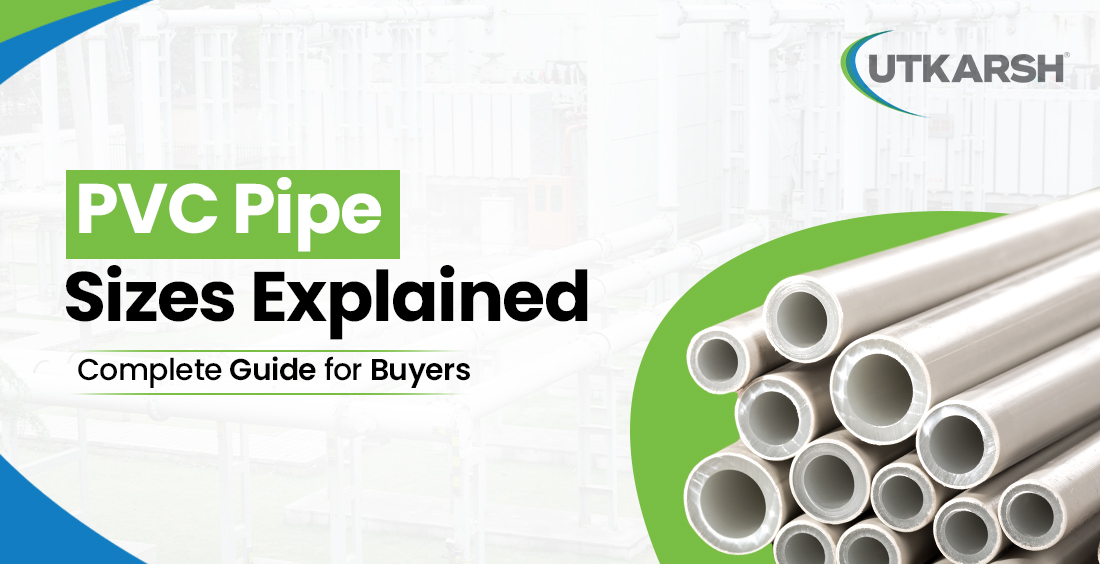PVC Pipe Sizes Explained Complete Guide for Buyers

From plumbing systems to construction and even backyard DIY projects, PVC pipes have made their mark. But like many other people try and understand which one to choose from. With multiple sizes available, choosing one to fit your needs isn’t always that simple. If you are asking what are standard PVC Pipe sizes or have had trouble memorizing codes in inches and mm, do not worry. This guide eliminates all the discrepancy and allows you to make decisions without ambiguity.
Also read: How do uPVC's non-toxic properties align with food safety goals?
What Are Standard PVC Pipe Sizes?
Most people ask first: what are standard pvc pipe sizes?
Most people ask first: what are standard pvc pipe sizes?
PVC pipes are generally classified based on their nominal pipe size (NPS), which doesn't always match the actual outside or inside diameter. That’s the reason why buyers get confused. Usually the standard size ranges anywhere between ½ inch to 24 inches in diameter which covers all residential, commercial and industrial appliances.
Also, the standard used is Schedule 40 and Schedule 80 which have different wall thicknesses and pressure capacities. While Schedule 40 is well suited for the majority of home plumbing work, Schedule 80 will tend to high-pressure applications.
PVC Pipe Sizes in MM and Inches
Understanding PVC pipe sizes in mm and inches is crucial for global compatibility. Manufacturers often list both to suit international and local markets. Here’s a basic size reference:
These common sizes are typically what you’d find in both residential plumbing and industrial setups. So, if you’re trying to match fittings or connectors, be sure to measure both the inner and outer diameter, not just the “named” size.
Types of PVC Pipes Based on Sizes
The variation in pvc pipe sizes is not just about diameter—it’s also about application and functionality.
Small-Diameter PVC Pipes (½” to 2”)
Used mainly in home plumbing, irrigation systems, and water distribution lines. These sizes are ideal for lower-pressure usage and are lightweight, easy to install, and budget-friendly.
Medium-Diameter PVC Pipes (3” to 6”)
These pipes are commonly used in drainage systems, rainwater collection setups, and medium-scale industrial applications. Their strength and capacity make them suitable for mid-level flow rates.
Large-Diameter PVC Pipes (8” and above)
Perfect for sewer systems, stormwater management, and large agricultural irrigation lines. These require more durable materials and are used in high-pressure systems.
Check this out: How to choose between CPVC and PVC pipes based on price and application?
How to Choose the Right PVC Pipe Size?
Making the right choice depends on several factors:
Pressure Rating: Larger sizes don’t always mean higher pressure capacity. Check the schedule (40 or 80) for wall thickness.
Flow Requirement: Consider the volume of water or fluid being moved. For high flow, you’ll need larger pvc pipe sizes.
Application Type: Residential plumbing might only need 1-inch pipes, while agricultural irrigation or factory drains could require 6-inch or larger.
Application Tips: Matching Pipe Sizes with Use
Let’s say you’re redoing your home’s plumbing. A 1-inch pipe might be enough for water supply lines, but your main drain might need a 3-inch pipe. Similarly, farms using PVC pipes for irrigation should check both pvc pipe sizes in mm and inches to ensure proper water distribution.
Always check compatibility with existing fittings, especially if you're connecting old systems to new PVC lines. Even a few millimeters off can cause leaks or pressure drops.
Your Go-To PVC Pipe Supplier: Utkarsh India
Whether you’re a DIY homeowner or a project manager running a large-scale installation, finding a reliable PVC Pipe supplier is key. Utkarsh India brings years of expertise to the table. Our extensive experience is reflected in our high-quality products, including a complete range of PVC pipes & fittings. We specialise in delivering solutions tailored to a variety of applications—from residential plumbing to industrial and agricultural uses.
Bonus Tip: Color Codes and Markings
One often-overlooked point in choosing the right pvc pipe sizes is understanding the color and markings. White pipes usually indicate potable water usage, while gray ones are used for electrical conduit. Some even have stripe markings to indicate intended use (e.g., blue for cold water, red for hot).
Conclusion
PVC pipes are incredibly versatile, but only if sized right. Always check both pvc pipe sizes in mm and inches for accuracy and compatibility. The more you understand how sizing works, the better your project outcome. So next time you pick up that clean, white tube—remember, it’s not just about length. It’s about flow, pressure, and precision.